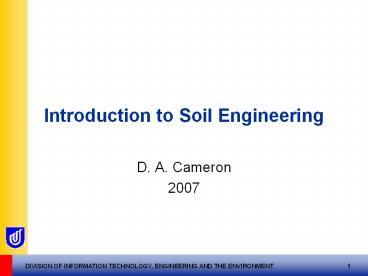Introduction to Soil Engineering - PowerPoint PPT Presentation
Title:
Introduction to Soil Engineering
Description:
Title: Molecular structure of the clay minerals Author: cameroda Last modified by: Office Created Date: 2/2/2002 12:36:45 AM Document presentation format – PowerPoint PPT presentation
Number of Views:894
Avg rating:3.0/5.0
Title: Introduction to Soil Engineering
1
Introduction to Soil Engineering
- D. A. Cameron
- 2007
2
StaffCIVIL ENGINEERING
- Dr. Don Cameron
- donald.cameron_at_unisa.edu.au
- P2-35
- ph 8302 3128
3
Reference
- Barnes, G E
- Soil Mechanics, Principles and Practice,
MacMillan Press - Civil Engineering students will need this
text in 3rd year
4
The engineering behaviour of soil
- How soils are formed
- The basic units which form soil material
- Engineering concepts of sand, silt and clay
- The Unified Soil Classification System
- Stress in soil, total and effective
- Water flow in saturated soils
- Erosion, scour or piping
- Physical improvement of soil (compaction)
- Terminology
5
Origins of Soils
- Residual
- Alluvial
- Aeolian wind blown
- Glacial
- Marine
- Lacustrine
- Organic
6
Water Transport and Soil Development
Mountains
Coastline
River valleys
Lakes, estuaries, deltas
Ocean
B, C
G
G
S
M silts
C, O (organic)
7
Soil from Rocks Residual
- SAND - quartz, silica
- SILT - finer quartz silica (842)
- CLAY - clay minerals (from
weathered feldspar mica ) - very fine clay particles
8
Particle Interactions
- Coarse soils v. Fine soils
- sand and gravel v. silt and clay
- STRENGTH DERIVED FROM
- Friction, interlock v.
- physico-chemical interaction
9
Clean Sand - under the microscope
angular particles from quarry
1 mm 1000?m
10
Fine - Grained Soils
- Cohesion
- Apparent cohesion
? apparent tensile strength, - arising from
- electrostatic forces
- (are stronger, the finer the particle)
11
Molecular Structure of the Clay Minerals
- Lecture 1
- Civil Engineering Practice
12
- http//pubpages.unh.edu/harter/crystal.htm
- Phyllosilicates
- are the clay building blocks
- ? Tetrahedrons Octahedrons
- Clays form from weathering and secondary
sedimentary processes - Clays are usually mixed
- other clays
- microscopic crystals of carbonates, feldspars,
micas and quartz
13
1. The Tetrahedron Unit
- Silica, Si4
- forms a tetrahedron
- with 4 x O2-
- Has a nett -ve charge of 4-
14
1. Silica Tetrahedron Unit
8-, 4
15
Tetrahedral sheets
- Formed by sharing of O2- between units
- Corner O2- shared, creating the sheet
- Nett ve charge at top of tetrahedral sheets!
16
Sharing
17
2. The Aluminium Octahedral Unit
- Al3 with six O2-
- Each oxygen ion is left
- with 1.5 ve charge
18
Aluminium Octahedra
19
Octahedral sheets
- Octahedral sheets formed by each oxygen being
bonded to two Al ions - Each O ion left with one ve charge
- IF charge satisfied by hydrogen ions,
- the Gibbsite mineral is formed
20
Sharing
21
The Kaolinite CLAY Mineral
- Top oxygen ions in Silica sheet bonded to
Aluminium sheet - 11 clay mineral
- Each top oxygen ion shared by 2 Al and 1 O ion
- This unit a clay micelle
- (approx. 0.7 nm thick and 10 x10 nm)
22
Kaolinite micelle
Gibbsite layer
Silicate layer
23
Kaolinite clay mineral
- consists of stacks of micelles
- Usually hydrogen bonds micelles together
- a strong bond
- stable clay mineral
24
Kaolinite
25
Kaolinite
26
21 Clay Minerals The Mica Group
- 3 sheets, 2 silica tetrahedra,
- 1 aluminium octahedron a micelle
- Many different clay minerals occur with this
basic unit - e.g. Illite (Adelaide clays) and
Montmorillonite (basaltic clays)
27
Smectite (includes montmorillonite)
28
Clay mineral 1x10-7 m
3. Aggregate 1 to 4x10-5 m
2. Clay mineral stack 0.1x10-6 m
- Clod 0.1 mm 1x10-4 m?
29
Properties of the clay minerals
- When mixed with a little water, clays become
plastic i.e. are able to be moulded - SO, moisture affects clay soil engineering
properties
30
Properties of the clay minerals
- Can absorb or lose water between the silicate
sheets - negative charge attracts H2O
- When water is absorbed, clays may
- Expand !
- water in spaces between stacked layers
- Montmorillonite most expandable
- Kaolinite the least
31
Illite v Montmorillonite Different forms
of bonding between these minerals
- Illite - main component of shales and
other argillaceous rocks - - stacks keyed together by K
- - nett negative charge
- Montmorillonite
- - stacks keyed together by Na or Ca
- and H2O
- - greater nett negative charge
32
Clay Minerals capacity for water
- i) Kaolinite (China clay)
Water absorption, approximately 90 - ii) Montmorillonite (Bentonite, Smectite)
Water absorption, approximately 300 - 700 - iii) Illite
Intermediate water absorption
33
Specific surface grain area/grain mass
34
The influence of charges
- The greater the surface area, the greater the
charge - the greater the affinity for water
- some water strongly adsorbed in a very thin layer
- other water free in the soil pores
- Electrostatic forces give rise to COHESION in
soils with clay minerals
35
Uses of Kaolinite
- Ceramics (China clay)
- Filler for paint, rubber plastics
- Glossy paper production
36
Uses of Montmorillonite The Smectite group
- facial powder (talc)
- filler for paints rubbers
- an electrical, heat acid resistant porcelain
- plasticizer in moulding sands
- drilling muds
- repairing leaking farm dams
37
In Summary
- The basic building blocks of clays are small
- Si, O, H and Al are the chief ingredients
- Tetrahedral octahedral sheets possible
- Different combinations of sheets form the basic
micelles of clay minerals - Clay mineral properties vary due to the nature of
bonding of the sheets between micelles
38
Revision
- What is a clay micelle?
- Describe how a 11 clay mineral is formed
- How does the Mica group of clay minerals differ
from the 11 clay minerals?































